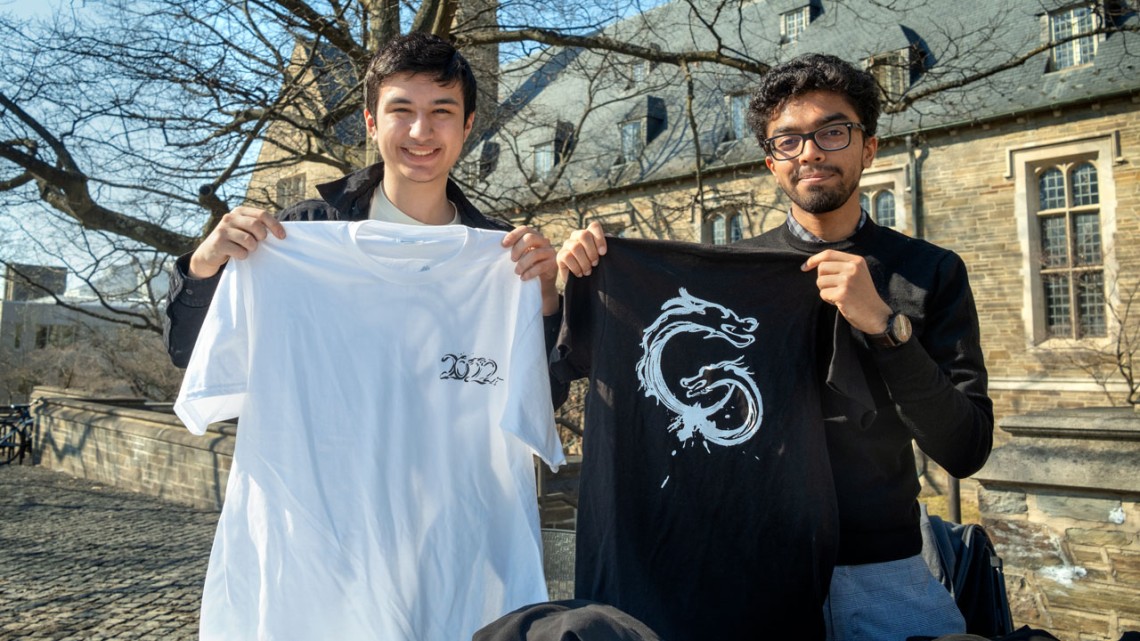
Jose Ortega, left, and Raihaan Bose hold Dragon Day 2022 T-shirts.
Return of the dragon: Two-headed beast revives Dragon Day
By James Dean
Hear ye, hear ye! Dragon Day, a more than century-old Ithaca campus tradition subdued these past two years by the global pandemic, shall be resurrected April 1 at 1 p.m.
So it has been decreed by a team of first- and second-year architecture students in the College of Architecture, Art and Planning (AAP), who are collaborating in historic fashion to design, build and release a dragon believed to be like none Cornellians have seen before: a two-headed monster crafted from recycled materials.
“We’ve got a bigger dragon, we’ve got two heads, we’ve got more people, we’ve got engagement on all levels,” said Oscar Llodra ’25, one of four Dragon Day co-captains along with Gabriella Melton ’25, Jose Ortega ’26 and Lily Mager ’26. “It’s going to be one for the books.”
Dragon Day historians will recall that around this time in 2020, then-first-year architecture students – the class that typically creates a dragon and parades it into the Arts Quad – were on the cusp of building one when campus shut down due to the emerging coronavirus threat. Ongoing COVID-19 restrictions sidelined Llodra’s class from leading the spring ritual last year.
But in an unprecedented partnership, this year’s first-year B.Arch students invited the class ahead of them to join forces in reviving Dragon Day, an event produced entirely by students and funded by T-shirt sales. The roughly 130-person team will collaborate on the dragon’s body while each class designs a distinctive head.
“There are a lot of advantages,” Ortega said. “It creates more bonding between our classes, there’s more people working on it, and the second-years have a little more experience, so I think it’s going to make the dragon even greater.”
In its spirit and construction, the 2022 dragon aims to promote sustainability – of resources and traditions.
The students plan to partner with the university’s recycling program to repurpose dozens of wooden pallets that will frame the dragon’s body and tail. Its skin and scales will materialize from discarded “plots,” the large pieces of paper architecture students use to print out and pin up drawings for critiques. Instead of being discarded, hundreds of square feet of plots will become part of a dragon that literally embodies the students’ hard work and creativity.
The salvaged materials are expected to reduce construction costs and have inspired the creature’s working name: Scrap Dragon.
For Melton, Dragon Day was part of what drew her to Cornell and AAP. It’s a celebration of architects, a way for students to show off their new design and fabrication skills, and an opportunity for each architecture class to grow closer and to prove their mettle.
“I’m so glad our class also gets to participate in this incredible tradition,” Melton said. “We can make something historic in the two-headed dragon, which has never been done before.”
“For us architecture students,” Ortega added, “maintaining this tradition is a very big responsibility.”
With the design still being finalized, the collaborators said the community should expect to see a dragon that might be the event’s largest yet, one that advances along its route aided by a cart and marching, costumed students who will be accompanied by performing artists.
“We really want to occupy the street,” Llodra said, “for this massive beast of a dragon to really fill space.”
The designers were contemplating movable components controlled mechanically or by student puppeteers, and potentially some special effects – all of which must come together in the week prior to April 1. Construction will begin behind The Foundry and move into the Sibley Hall parking lot as the dragon takes shape.
The parade route will start there on University Avenue, turn right on Feeney Way (formerly East Avenue) and again on Campus Road, then traverse Ho Plaza before entering the Arts Quad. The journey traditionally includes an encounter with College of Engineering students who may present a phoenix to greet Scrap Dragon.
“The whole process attests to the profession as a whole, because it’s a huge collaborative project,” Melton said. “Constructing this giant dragon that potentially has moving parts is an impressive feat, but it will stand the test of time in terms of how close your class becomes at the end of that week.”
Get Cornell news delivered right to your inbox.
Subscribe
